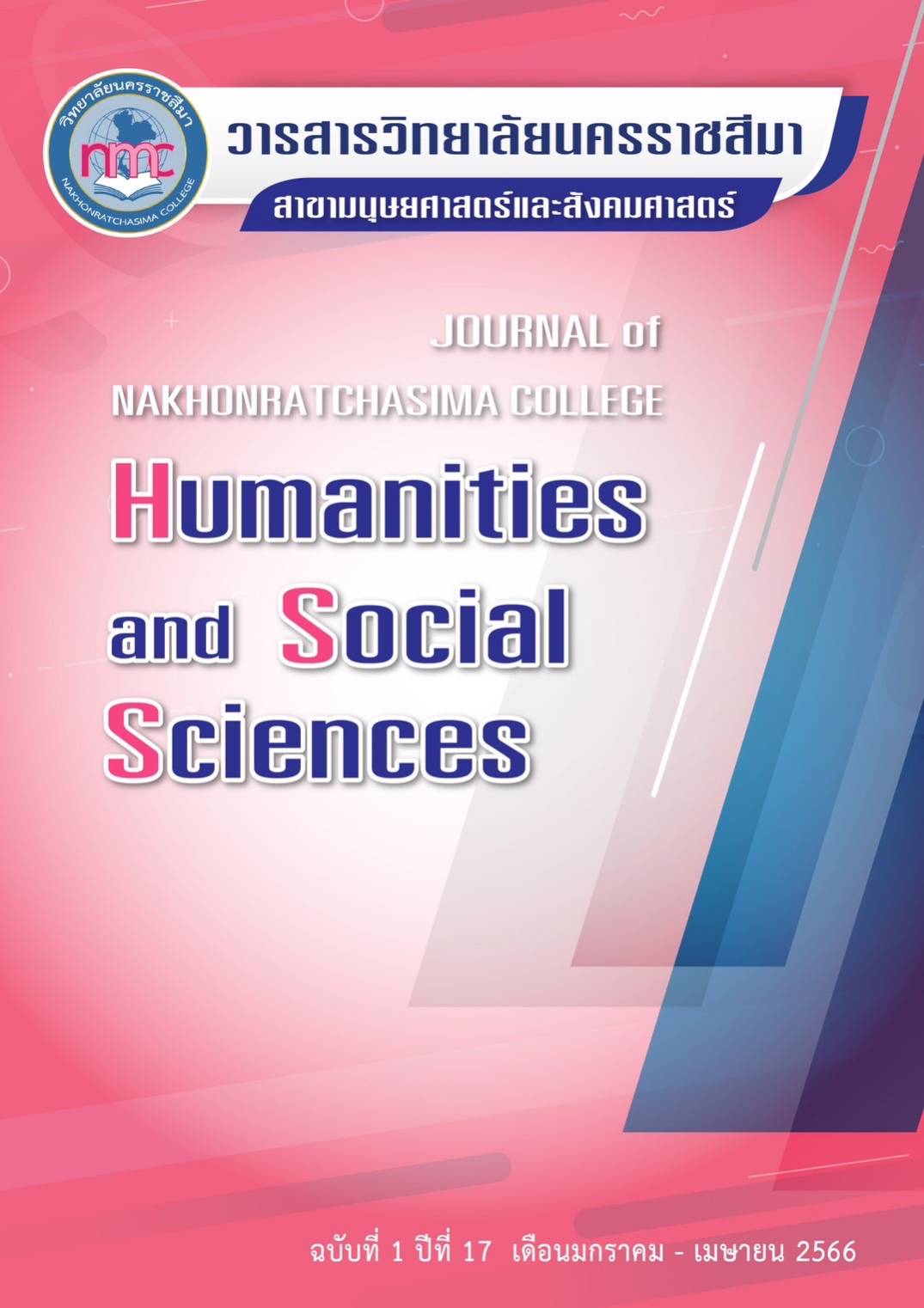โมเดลเชิงสาเหตุของภาวะผู้นำการเปลี่ยนแปลง พฤติกรรมการเป็นสมาชิกที่ดีขององค์การ การทำงานเป็นทีมและความพึงพอใจในงานที่ส่งผลต่อความผูกพันต่อองค์การของนักกีฬามวยไทยอาชีพในธุรกิจค่ายมวยไทย
The Causal model of Transformational LeadershipOrganizationalCitizenship Behavior Teamwork and Job Satisfaction AffectingOrganizational Commitment of Professional Muay Thai Athletesin MuayThai Camp Business
คำสำคัญ:
ภาวะผู้นำการเปลี่ยนแปลง, พฤติกรรมการเป็นสมาชิกที่ดีขององค์การ, การทำงานเป็นทีม, ความพึงพอใจในงาน, ความผูกพันต่อองค์การบทคัดย่อ
การวิจัยครั้งนี้มีวัตถุประสงค์เพื่อ1) ศึกษาระดับภาวะผู้นำการเปลี่ยนแปลง พฤติกรรมการเป็นสมาชิกที่ดีขององค์การ การทำงานเป็นทีม ความพึงพอใจในงาน และความผูกพันต่อองค์การของนักกีฬามวยไทยอาชีพในธุรกิจค่ายมวยไทย 2) ศึกษาอิทธิพลของปัจจัยเชิงสาเหตุที่ส่งผลต่อความผูกพันต่อองค์การของนักกีฬามวยไทยอาชีพในธุรกิจค่ายมวยไทย 3) สร้างโมเดลเชิงสาเหตุของภาวะผู้นำการเปลี่ยนแปลง พฤติกรรมการเป็นสมาชิกที่ดีขององค์การ การทำงานเป็นทีม และความพึงพอใจในงานที่ส่งผลต่อความผูกพันต่อองค์การของนักกีฬามวยไทยอาชีพในธุรกิจค่ายมวยไทยโดยการผสมผสานวิธีวิจัยเชิงคุณภาพและวิธีวิจัยเชิงปริมาณประชากรคือ นักกีฬามวยไทยอาชีพผู้ฝึกสอน และผู้บริหารจากค่ายมวยไทยในเขตกรุงเทพมหานคร สุ่มตัวอย่างแบบเป็นระบบรวม 272 แห่ง สุ่มตัวอย่างแบบง่าย ได้กลุ่มตัวอย่าง จำนวน 400 คนวิเคราะห์ข้อมูลด้วยโปรแกรมสำเร็จรูปทางสถิติ ส่วนการวิจัยเชิงคุณภาพใช้วิธีการสัมภาษณ์เชิงลึกผู้เชี่ยวชาญ 6 คน วิเคราะห์ข้อมูลโดยการวิเคราะห์เนื้อหา เครื่องมือที่ใช้ในการวิจัย 1) แบบสอบถาม 2) แบบสัมภาษณ์สถิติที่ใช้ในการวิเคราะห์ข้อมูลได้แก่ ค่าเฉลี่ยอิทธิพลของปัจจัยเชิงสาเหตุ และการวิเคราะห์โมเดลสมการโครงสร้าง
ผลการศึกษาพบว่า
1. ระดับพฤติกรรมการเป็นสมาชิกที่ดีขององค์การ ภาวะผู้นำการเปลี่ยนแปลง การทำงานเป็นทีม ความพึงพอใจในงานและความผูกพันต่อองค์การของนักกีฬามวยไทยอาชีพในธุรกิจค่ายมวยไทย อยู่ในระดับมาก
2. อิทธิพลของปัจจัยเชิงสาเหตุที่ส่งผลต่อความผูกพันต่อองค์การของนักกีฬามวยไทยอาชีพในธุรกิจค่ายมวยไทยสามารถทำนายผู้นำการเปลี่ยนแปลงในการส่งผลต่อความผูกพันต่อองค์การ ผ่านพฤติกรรมการเป็นสมาชิกที่ดีขององค์การ การทำงานเป็นทีม และความพึงพอใจในงาน ร้อยละ 71 อย่างมีนัยสำคัญทางสถิติที่ระดับ .05
3. โมเดลเชิงสาเหตุของภาวะผู้นำการเปลี่ยนแปลง พฤติกรรมการเป็นสมาชิกที่ดีขององค์การ การทำงานเป็นทีมและความพึงพอใจในงานที่ส่งผลต่อความผูกพันต่อองค์การของนักกีฬามวยไทยอาชีพในธุรกิจค่ายมวยไทยดัชนีความกลมกลืน ดังนี้ c2 = 100.209,c2/df = 1.222, p-value = .084 , GFI = .971, AGFI =.945, CFI = .996, RMSEA = .024, SRMR = .006โมเดลเชิงสาเหตุที่พัฒนาขึ้น ชื่อว่า IASIC Model(I=Individualized, A=Altruism S=Support, I=Intrinsic and C=Continuance)
เอกสารอ้างอิง
กระทรวงการท่องเที่ยวและกีฬา.(2560) แผนพัฒนาการกีฬาแห่งชาติ ฉบับที่ 6. (พ.ศ.2560-2564) สืบค้น ณ มกราคม 2565,https://www.mots.go.th.
ณัฐพร ฉายประเสริฐ วันเพ็ญ อยู่เป็นสุข สุวภัทร ศรีสว่าง และ ชญชา สุดเวหา (2560) การจัดการส่งผลต่อความผูกพันต่อองค์การโรงงานอุตสาหกรรมจังหวัดปทุมธานี. วารสารวิชาการ วิทยาลัยนครราชสีมา, 11(3), 71-80.
เตชิตา ไชยอ่อน. (2557). ความคาดหวังของลูกค้าชาวต่างชาติที่มีต่อคุณภาพการให้บริการของค่ายมวยไทย. ภาคนิพนธ์ศิลปศาสตร์ สาขาวิชาการจัดการภาครัฐและเอกชน, มหาวิทยาลัยศิลปากร.
บุญใจ ศรีสถิตนรากูร. (2555). การพัฒนาและตรวจสอบคุณภาพเครื่องมือวิจัย : คุณสมบัติการวัดเชิงจิตวิทยา. กรุงเทพฯ : จุฬาลงกรณมหาวิทยาลัย.
พงษ์ธวัช จันทรบูลย์ และ วิชิต อู่อ้น (2559). ตัวแบบความผูกพันต่องานที่ส่งผลต่อผลการปฏิบัติงานของบุคลากรกีฬาในสมาคมกีฬาแห่งประเทศไทย. วารสารสันติศึกษาปริทรรศน์ มจร 5(3), 237-249.
สมาคมมวยไทยอาชีพแห่งประเทศไทย (2565). การกีฬาแห่งประเทศไทย 286 ถนนรามคำแหงแขวงหัวหมาก เขตบางกะปิ กรุงเทพฯ 10240 โทร. /โทรสาร 02 300 4297 e-mail: samakom.muaythai@gmail.com
Allen N. J. and Meyer J.P. (1990). The Measurement and Antecedents of Affective, Continuance and Normative Commitment to the Organization. Journal of Occupational Psychology, 63(1), 1-18.
Burns, J. M. (1978). Leadership. New York: Harper and Row.
Chelladurai, P. (1994). Sport Management. Defining the Field. European Journal for Sport Management, 1, 7-21.
Chen, C. Ding, X. & Li, J. (2021). Transformational Leadership and Employee Job Satisfaction: The Mediating Role of Employee Relations Climate and the Moderating Role of Subordinate Gender. Journal of Environmental Research Public Health. 2022 Jan; 19(1): 233.
Cronbach, L. J. (1951). Coefficient alpha and the internal structure of tests. Psychometrika, 16, 297–334.Frontiers in Psychology.
Hair, J.F., Black, W.C., Babin, B.J. and Anderson, R.E. (2010). Multivariate Data Analysis. 7th Edition, Pearson, New York.
Khan, S.-U.-R., Anjam, M., Abu Faiz, M., Khan, F., & Khan, H. (2020). Probing the Effects of Transformational Leadership on Employees’ Job Satisfaction With Interaction of Organizational Learning Culture. SAGE Open, 10(2), 1-9.
Kline, R. B. (2005). Principles and practice of structural equation modeling (2nded.).New York: Guilford.
Liou. (2008). An Analysis of the Concept of Organizational Commitment. Nursing Forum, 43(3), 116-125.
Massoudi, A, H., Jameel, A. S. & Ahmad, A. R. (2020). Stimulating Organizational Citizenship Behavior by Applying Organizational Commitment and Satisfaction. International Journal of Social Sciences and Economic Review, 2(2), 20-27.
Nastasi, B. K., & Schensul, S. L. (2005). Contributions of qualitative research to the Validityof intervention research. Journal of School Psychology, 43(3), 177–195.
Panicker, R. Lee, M. C. C. (2019). Transformational Leadership and Teamwork Attitude: Trust and Collective Efficacy as Mediators. Selection and peer-review under responsibility of the Organizing Committee of the conference ISSN: 2357-1330
Purwanto, A., Purba, J. T. l, Bernarto, I. &Sijabat, R. (2021). Effect of transformation leadership, Job satisfaction, and Organizational Commitments on Organizational Citizenship Behavior. INOBID JurnalInovasiBisnis dan Management Indonesia, 9(1), 61-69.
Riyadi, R.P.&Auliya, Z. F.(2021). The Role of Employee Empowerment, Teamwork And Employee Training on Organizational Commitment. Journal of Management and Islamic Finance 1(1),48-63.
Robbins, S.P. (2001). Organization Behavior (9thed.). New Jersey: Prentice-Hill.
Robbins, S. P. (2002). Management (7th ed). Englewood Cliffs, NJ: Prentice-Hall.
Robbins, S.P. (2009). Essentials of Organizational Behavior (8th ed.). Pearson Education, Inc., Prentice Hall.
Saari, L. M., & Judge, T.A. (2004). Employee Attitudes and Job Satisfaction. Human Resource Management, 8(12), 395-407.
Singh, Ajay & Gupta, Bindu. (2015). Job Involvement, Organizational Commitment, Professional Commitment, and Team Commitment A Study of GenerationalDiversity. Benchmarking: An International Journal, 22(6), 1192-1211.
Tian, H., Iqbal, S., Akhtar, S., Qalati, S. A., Anwar, F., & Khan, M. A. S. (2020). The Impact of Transformational Leadership on Employee Retention: Mediation and Moderation Through Organizational Citizenship Behavior and Communication. Frontiers in Psychology,11,314, 1-11.
Winarsih, T & Fariz. (2021). The Effect of Job Satisfaction on Organizational Commitment and Work Discipline. Budapest International Research and Critics Institute-Journal (BIRCI-Journal) 4(1), 1328-1339.
Yamane, T. (1973) Statistics: An Introductory Analysis. 3rd Edition, Harper and Row, New York.
ดาวน์โหลด
เผยแพร่แล้ว
รูปแบบการอ้างอิง
ฉบับ
ประเภทบทความ
สัญญาอนุญาต
จรรยาบรรณผู้เขียนบทความ
ผู้เขียนบทความต้องรับรองว่าบทความนี้ไม่เคยตีพิมพ์ในวารสารใดหรือสิ่งพิมพ์อื่นๆ มาก่อน ต้องไม่คัดลอกผลงานผู้อื่นมาปรับแต่งเป็นบทความของตน และไม่ได้อยู่ระหว่างการเสนอเพื่อพิจารณาตีพิมพ์ อีกทั้งยอมรับหลักเกณฑ์การพิจารณาและการตรวจแก้ไขบทความต้นฉบับโดยกองบรรณาธิการวารสารวิทยาลัยนครราชสีมา สาขามนุษยศาสตร์และสังคมศาสตร์
บทความทุกเรื่องได้รับการตรวจพิจารณาทางวิชาการโดยผู้ทรงคุณวุฒิที่มีประสบการณ์และมีความเชี่ยวชาญตรงตามสาขาของบทความ ซึ่งผู้เขียนต้องแก้ไขตามคำแนะนำของผู้ทรงคุณวุฒิภายในระยะเวลาที่กำหนด หากไม่เป็นไปตามกำหนดกองบรรณาธิการขอสงวนสิทธิ์และยกเลิกการตีพิมพ์โดยจะแจ้งให้ทราบต่อไป
ข้อความที่ปรากฏในบทความของวารสารนี้เป็นความคิดเห็นของผู้เขียนซึ่งไม่เกี่ยวข้องกับวิทยาลัยนครราชสีมาแต่อย่างใด และกองบรรณาธิการขอสงวนสิทธิ์ในการพิจารณาและตรวจประเมินบทความเพื่อตีพิมพ์ในวารสารของวิทยาลัยนครราชสีมา สาขามนุษยศาสตร์และสังคมศาสตร์



